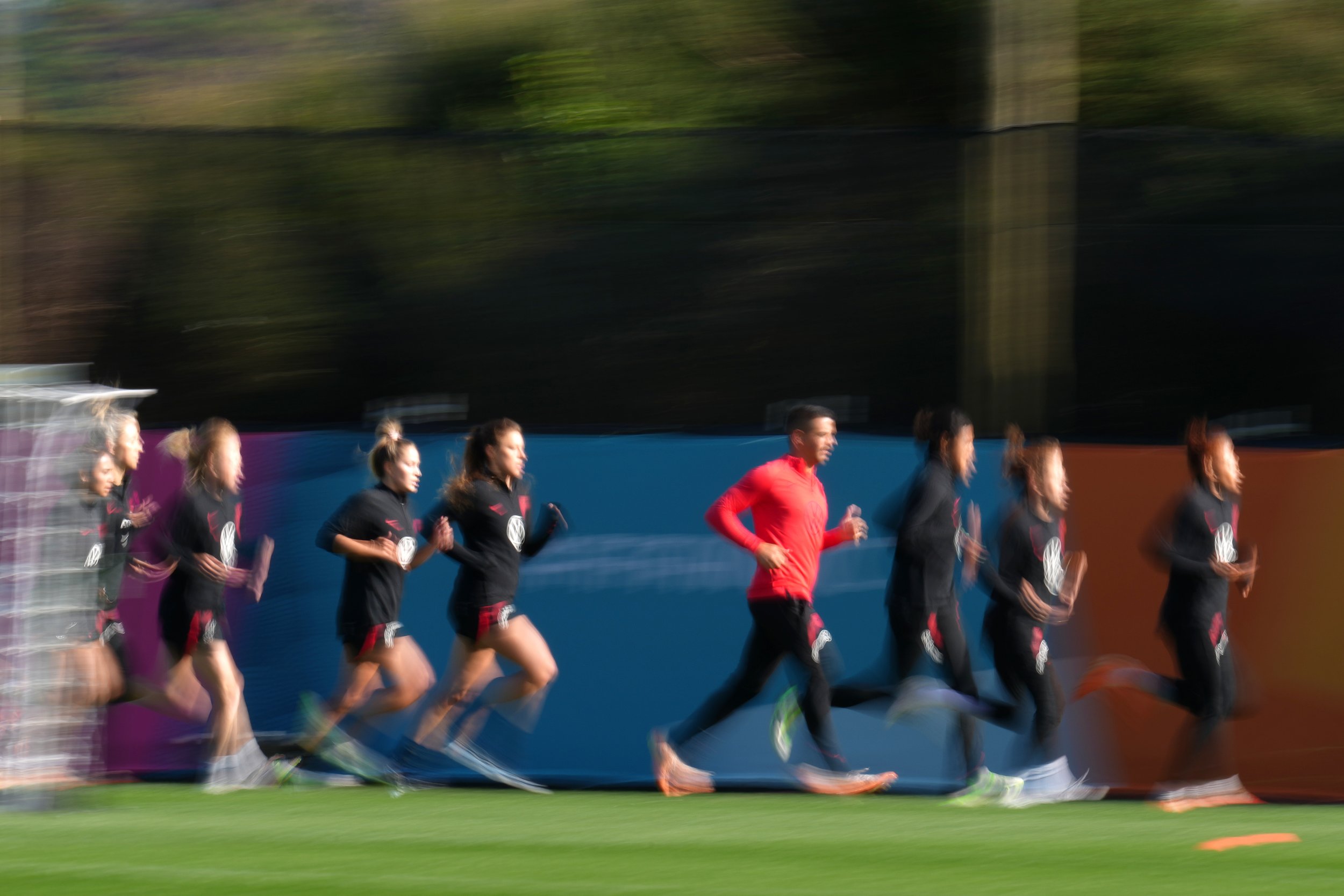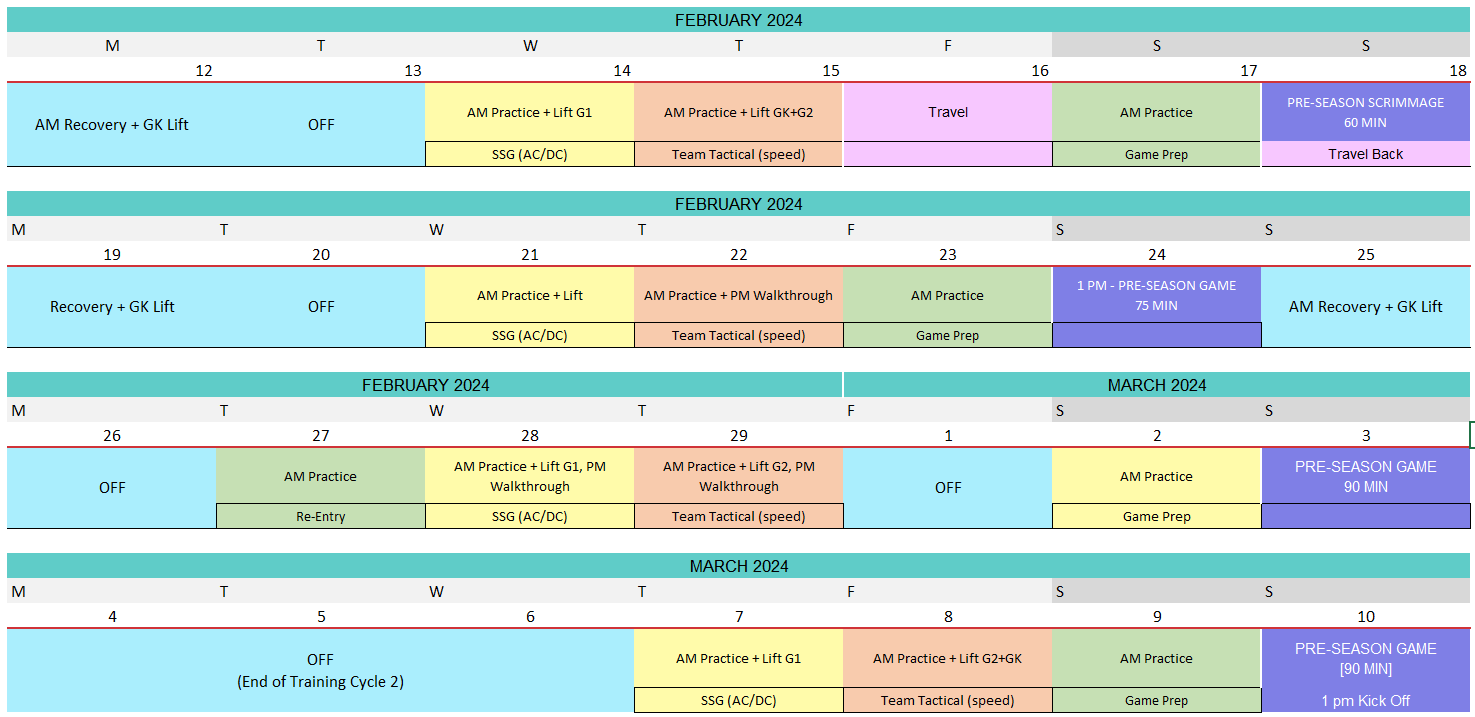A Look Into Pro Soccer Team Training Periodization
Do you wonder how pros train and stay fit through the season? Here's a look into the planning, nuances, and application of periodization in a professional soccer environment.
Do you wonder how pros train and stay fit through the season? Here's a look into the planning, nuances, and application of periodization in a professional soccer environment.
Long Term Planning (Macrocycle)
It all starts with the big picture. A high level look at the key dates within a calendar year is enough to identify unique periods with different demands. For example, the NWSL has 3 major periods:
Pre-Season: early period that runs from end of January through mid March (~6 weeks), intended to give teams time to physically prepare for the imminent season.
Season: the competition period, which runs from mid-March through mid-November (if you're good enough to make it that far 😁).
Off-Season: a break period, from mid November through late January, to allow teams and athletes a break from work, vacation time, and for some, a time to recover from issues developed during the season.
Each of the periods above differ in length, allow for different work interactions and interventions, and demand different physical outputs and recovery time.
Training Cycles and Weekly Rhythms (Mesocycles)
From this breakdown, we can begin to dive deeper and develop training cycles and rhythms. This will allow for more details but not quite everything yet.
Weekly Rhythms are the combination of training days and games that repeat within a Training Cycle.
Training Cycles are a sequence of Weekly Rhythms that offer a progressive overload of physical demands to stimulate athletes to adapt to such demands overtime, followed by a longer than normal recovery period to allow adaptations to take place before the start of the next Training Cycle.
Let's look, for example, at the Pre-Season period. There are six weeks available, all players are required to be with the team, and friendly games can be scheduled.
For many of the teams, this is also a time to travel, get away from bad weather, and take time for new teammates and staff to get to know each other.
We could schedule 6 games, since games are what we are ultimately preparing for, each on a Saturday or Sunday, to begin developing a weekly rhythm similar to that of the NWSL games. In the process of scheduling games, opponents’ schedule preferences and traveling dates create challenges to our perfect one week rhythm of game - six days - game, so a variety of Weekly Rhythms begin to form.
The basic Sunday-to-Sunday rhythm may look like this:
Sunday: Game
Monday: Recovery
Tuesday: Off
Wednesday: Training
Thursday: Training
Friday: Training
Saturday: Training
Sunday: Game
This could be repeated over 3 weeks, starting with a relatively easy week of training and short game, followed by progressively harder training and longer games each consecutive week.
But what goes into the decision process for what to do each day?
Weekly Details (Microcycles)
It all starts with the games. If we play on a Sunday, using the rhythm example above, we can begin to build backwards from there using a GD+/- system.
Game Day -1
The day before a game is a day for final tactical adjustments and technical sharpening. We want a quick recovery process following this training, so the volume of training should be low. Depending on the preceding days, it may be appropriate to implement short bursts of high intensity actions here, especially with competitive activities, working as a final rehearsal.
Game Day -2
Two days out we should still proceed with caution. Some highly stressful exercises, such as maximal velocity sprinting, can demand for more than 48hrs of recovery for damaged tissues to fully recover. Since GD -3 and GD -4 are further from the game and ideal for physical overloads, this day most oftenly becomes a day for recovery exercises or low volume/low intensity activities such as Tactical Walkthroughs and Set Pieces.
Game Day -3, Game Day -4
As mentioned above, highly stressful activities lead to 48+ hours of recovery needs. This means that following a game, players would need 2 full days dedicated to recovery, leaving GD -4 and GD -3 as the best options for exercises which will overload athletes physically to drive adaptations.
To make the most of both days, we'll focus on different but complementary movement and energy qualities on each of them. To accomplish this using soccer training, we'll guide the coaching staff on how to adjust variables within their technical/tactical exercises that lead to these specifications.
On GD -3, we will use larger space between players (relative to normal game spacing) to stimulate a higher amount of linear running mechanics, higher maximal velocities, and consequently higher intensity decelerations. However; the increased player spacing will lead to a lower amount of unique actions relative to the duration of the exercise. This simple variable adjustment leads to a greater overload of speed, more stress on the posterior chains of soft-tissues, and an overall increase in intensity.
To compensate for the increased intensity, we will also suggest exercises are built with a high amount of stoppage from coaching during the action or work to rest ratios that favor higher amounts of rest between reps.
Alternatively; on GD -4, we will use tighter spaces between players to stimulate unique actions to occur more often relative to exercise duration. This overload of actions means athletes will need to stop and transition to new movements more often, causing an overload to the anterior chain of soft-tissues as they push the ground away repeatedly.
The repeated changes in action and tighter spaces prevent athletes from reaching high velocities, which means the amount of force required to stop and reaccelerate the body will be lower, blunting intensity levels. Since intensity is relatively lower, we can use work to rest ratios that favor working durations and relatively lower rest periods.
There are many other variables we can and should consider while designing training exercises, so we'll save them for a separate write up.
GD +2 and GD +1
We've discussed the potential need for 48+ hours of recovery after highly demanding activities, and competitive games are as demanding as they will get. So, both days should be used for recovery. However, different scenarios still present themselves within these two relatively simple days.
For example; if GD +1 is following an evening game, it may be wise to be fully off on the following day, since athletes tend to have difficulties with falling asleep after the adrenaline rushes of elite competition. But if the team must travel on GD +1, it may be more beneficial for athletes to go through a recovery session before or after their flights and enjoy a full day off on the following day.
Recovery sessions consist of low stress exercises designed to enhance blood flow to soft tissues while minimizing additional damage. Blood brings nutrients and removes by-products, which are rinsed through the liver and kidneys and wasted by the body. Several other recovery modalities have been tirelessly studied, but ultimately, the most meaningful factors in recovery ability are duration and quality of sleep, hydration, and refueling of essential nutrients.
Questions?
This is a high level view of the planning processes and a simple look at the nuances in it. I plan on writing a deeper dive into the variables that influence physical demands of soccer practices and its exercises, but for now, please feel free to comment with any questions to learn more.






